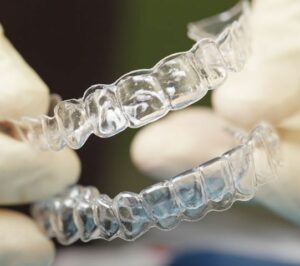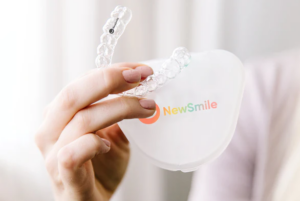Overcorrection aligners shape teeth slightly more than needed so that upon settling, they align correctly. These aligners, also known as refinement aligners, are typically utilized in the later stages of aligner treatment.
They help address rotations, alignment issues, and various tooth movements crucial for optimal results. A retrospective study from The Angle Orthodontist, concludes that to enhance clear aligner therapy performance, integrating overcorrection in the initial digital setup is crucial.
The significance of overcorrection lies in maintaining long-term alignment stability. By ensuring teeth remain slightly over-aligned, any potential shifts are accommodated, supporting a sustained aligned smile.
Table of Contents:
- How Overcorrection Aligners Differ from Traditional Methods?
- Are Overcorrection Aligners Effective?
- Do You Truly Need Overcorrection Aligners?
- Top 3 Overcorrection Aligner Products
- Ideal Candidates for Overcorrection Aligners?
- After the Overcorrection Journey
- How Long Do You Wear Overcorrection Aligners?
- Addressing Concerns: Overcorrection Aligners Impact on Dental Health
- What To Do if Overcorrection Aligners Are Making Teeth Worse?
- FAQs
How Overcorrection Aligners Differ from Traditional Methods?
While traditional braces offer a tried-and-tested method for straightening teeth, clear aligners provide a convenient alternative. The key difference between braces and aligners is that the latter are discreet, removable, and comfortable. The newer “overcorrection” aligners take this technology even further by anticipating natural tooth movement for an even more stable smile.
Overcorrection aligners grip teeth tightly, then gradually release, guiding them back to the perfect alignment. This counteracts the natural tendency for teeth to drift back, anchoring your smile in the long run.
Unlike retainers, aligners, and passive aligners, overcorrection aligners strategically push teeth slightly past ideal alignment, anticipating natural relapse and ensuring long-term stability.
Are Overcorrection Aligners Effective?
Overcorrection aligners, necessary in Invisalign treatment, notably increase posterior teeth contact post-orthodontic treatment. Evidence from a 2023 clinical study highlights their contribution to enhanced dental alignment.
An article from the Dental Press Journal of Orthodontics proposes that in planning aligner treatments, overcorrection of several tooth movements is recommended, recognizing that not every planned movement will be fully expressed.
These aligners are great at preventing teeth from moving back, keeping your smile steady for a long time. Studies show they work well, and orthodontists often suggest them because they’re crucial for keeping teeth aligned and steady. This emphasizes how important they are for successful Invisalign treatments.
Do You Truly Need Overcorrection Aligners?
Whether overcorrection aligners are needed or not depends heavily on your teeth conditions and the issues you want to treat. Here’s a short breakdown.
When They’re Useful:
- Complex Moves: For significant rotations, expansions, or bite adjustments, overcorrection acts as a “power boost,” ensuring teeth settle into their final positions precisely.
- Prevent Relapse: If your teeth tend to shift back, overcorrection provides an extra layer of protection.
- Fine-tuning: They’re handy in the end to fix tiny imperfections for that dazzling smile.
When They Might Not Be Needed:
- Simple Adjustments: For small fixes, a regular invisible tooth aligner might be enough and you don’t need to spend extra money and time.
- Good Compliance: If you wear your aligners as required by the specialist, natural settling after treatment can work just fine.
- Cost Consideration: Overcorrection adds cost. Think about whether the extras are worth it for you.
Top 3 Overcorrection Aligner Products
I have found Byte brand products to be the best for overcorrection aligners. Candid and AlignerCo invisible aligners closely follow as excellent runner-ups.
Byte offers precision through custom aligners while still maintaining convenience with a user-friendly app, affordability, and efficient progress tracking. Byte works by delivering custom aligners on a regular basis directly to your doorstep.
AlignerCo prioritizes personalized treatment via tailored plans and affordable financing options. Their at-home dental impressions and direct dentist collaboration ensure a precise fit and expert oversight. Ideal for those seeking individualized plans and accessible costs.
Candid Aligners excel in discretion and comfort, backed by professional assessments. They offer in-person scans and unlimited refinements, promising shorter treatment times. Catering to those valuing comfort and premium professional care. Candid aligners are an option for those who want in-office visits. Find further insights in our detailed Candid aligner review.
 Best Overall
Best Overall 

- Customized aligners for a precise fit
- Fast-acting treatment plans
- Lifetime guarantee
- Easy-to-use app to track your progress
 Runner-Up
Runner-Up 

- Tailored treatment plan for each individual
- Affordable cost, with ease of financing
- At-home dental impressions
 Third Place
Third Place 

- Comfortable and discreet aligners
- Assessment by dental professionals
- Shorter treatment times
Ideal Candidates for Overcorrection Aligners?
Patients who require refinement of dental alignment are in need of overcorrection aligners. They often exhibit resistance to initial treatment or still require specific movements after aligners have already been used.
Factors indicating you might need overcorrection aligners include – moderate to severe misalignment not fully resolved by initial treatment, stubborn teeth requiring additional refinement, and bite issues affecting dental health and aesthetics.
Individuals seeking improved smile aesthetics or addressing bite concerns also qualify for the overcorrection. However, consulting a dental professional is crucial as ordinary aligners might achieve the same job just as well.
After the Overcorrection Journey
Settling In. Your teeth will naturally settle for a short period. This settling is why overcorrection pushes past the ideal alignment initially.
Retention is Key. To lock in your stunning smile, you’ll graduate to retainer wear. Expect to wear them diligently for an initial period, gradually phasing them down under your dentist’s guidance.
Smiling Wide. Bask in the satisfaction of a straight, healthy smile. Whether you desire perfect alignment, bite correction, or aesthetic tweaks, overcorrection will make it possible.
Regular Checkups. Schedule regular checkups with a professional in-office or at home to monitor the continued stability of your teeth and ensure long-term oral health.
Patience is key during post-treatment. Trust the process, follow the instructions of professionals, and enjoy the fruits of your overcorrection journey: a confident, radiant smile for years to come.
How Long Do You Wear Overcorrection Aligners?
Typically, overcorrection aligners are worn for an additional period after the initial treatment. Dental professionals tailor the timeframe based on teeth response and desired alignment goals.
For example, moderate or severe dental misalignments might require you to wear them for several weeks. Intrusive movements, rotations, and overcrowding cases require aligners to be used for up to three months every day.
It’s vital to adhere strictly to the prescribed wearing schedule to achieve successful refinement. For precise information on how long do you have to wear aligners, consult your dental or orthodontic provider, as they’ll determine the exact duration based on your unique case.
Addressing Concerns: Overcorrection Aligners Impact on Dental Health
Overcorrection aligners refine dental alignment without causing significant harm. Taking good care of your teeth during such treatment helps avoid damage possible. Practice good oral hygiene and track the progress, so that aligners don’t move the teeth in directions they aren’t meant to.
It’s crucial to talk with a professional to make sure overcorrection aligners suit your dental needs for a safe and custom plan. For tips on how to deal with aligner pain, ask your dentist and read our comprehensive guide.
What To Do if Overcorrection Aligners Are Making Teeth Worse?
Overcorrection aligners might seem to worsen your teeth if used incorrectly. In some cases, they might be incorrectly prescribed. If you thinking overcorrection aligners are making your teethworse, follow these steps.
Prioritize oral hygiene: Maintain proper oral care during Invisalign treatment to minimize chances of bad smell or bacteria.
Monitor progress: Keep track of changes and inform your orthodontist about any significant shifts. Most at-home aligner brands have convenient methods to monitor progress regularly.
Contact your orthodontist: If you feel that instructions and tracking is not enough, don’t wait and discuss your concerns directly with a healthcare professional.
FAQs
Are refinement aligners the same as a retainer?
No. Retainers maintain the achieved teeth alignment post-Invisalign completion. Refinement aligners achieve the goal of shifting certain teeth slightly beyond perfect alignment.
Can overcorrection aligners fix severe teeth misalignment?
Overcorrection aligners are effective in addressing severe teeth misalignment by adjusting specific teeth just beyond perfect alignment. However, determining their suitability for your specific case requires consultation with a dental or orthodontic professional.
Do overcorrection aligners cause discomfort during wear?
Overcorrection aligners can lead to temporary discomfort, which usually diminishes as teeth adapt to their new position. Discomfort levels vary based on case complexity and specific tooth movements.
How often should I wear overcorrection aligners each day?
Wear overcorrection aligners 20-22 hours daily for optimal results. Occasional shortfalls won’t harm alignment, but inconsistent use disrupts the treatment’s intended tooth movement. Each set is worn for about two weeks, ideally for at least one week before changing, unless advised differently by the doctor.
Can I switch to overcorrection aligners if I’ve already started Invisalign treatment?
Transitioning to overcorrection aligners during ongoing Invisalign treatment is possible. However, consulting your orthodontist is crucial to confirm their necessity for your case.

